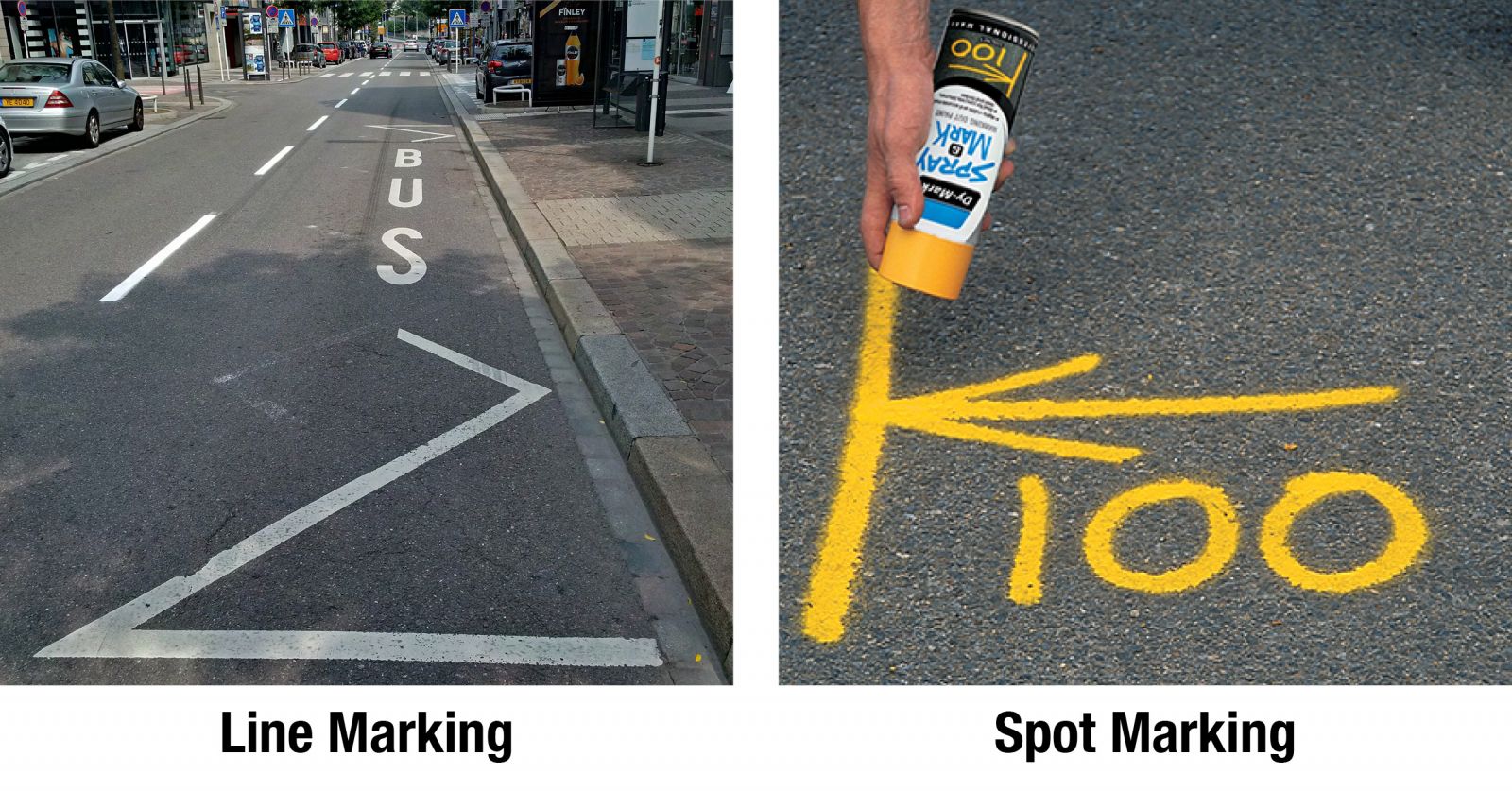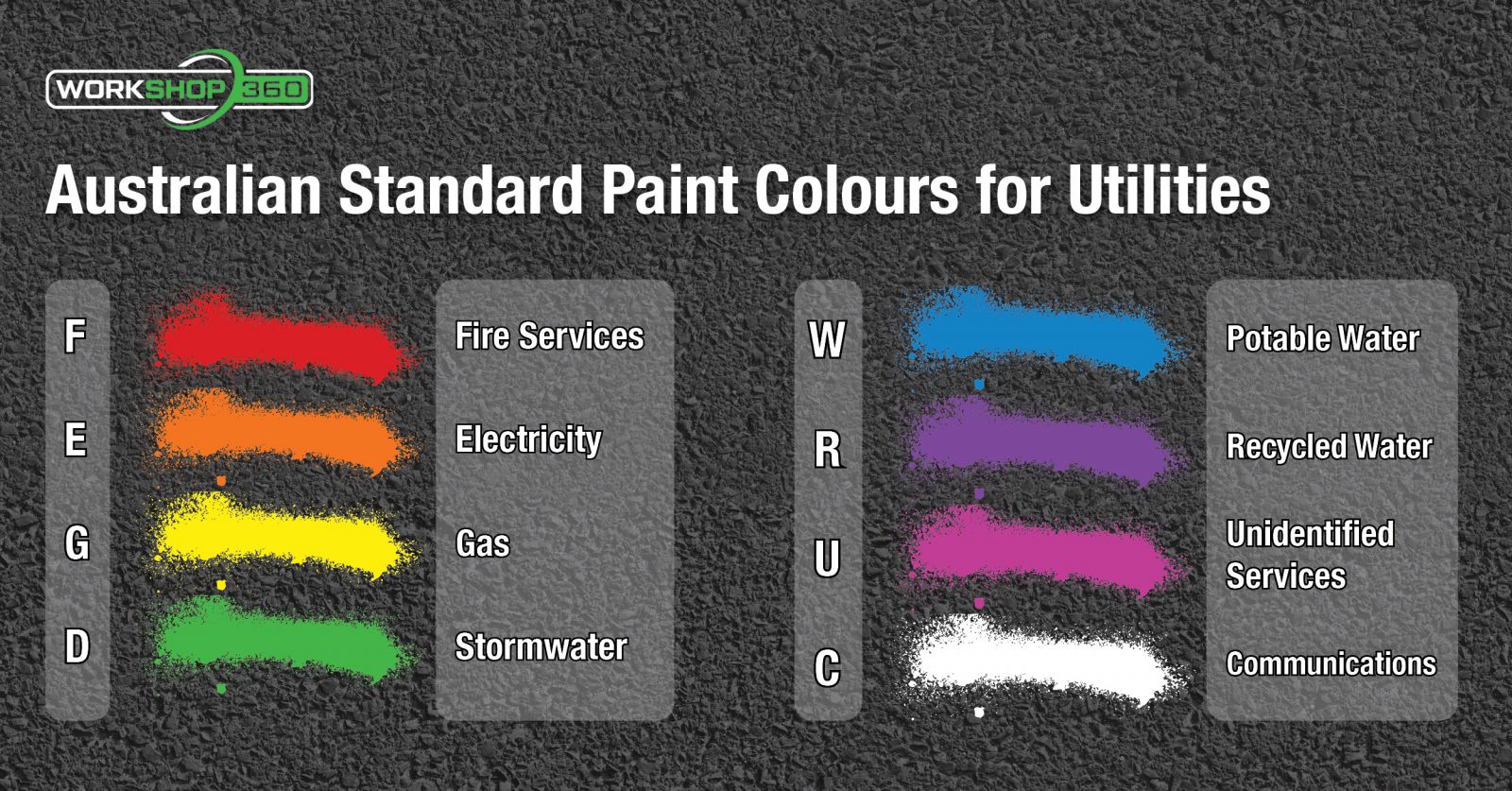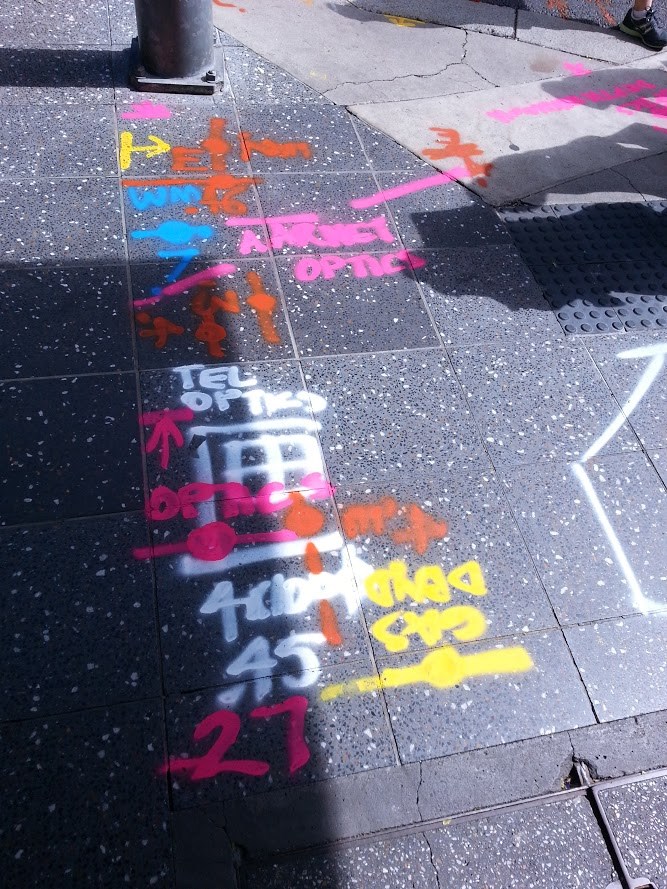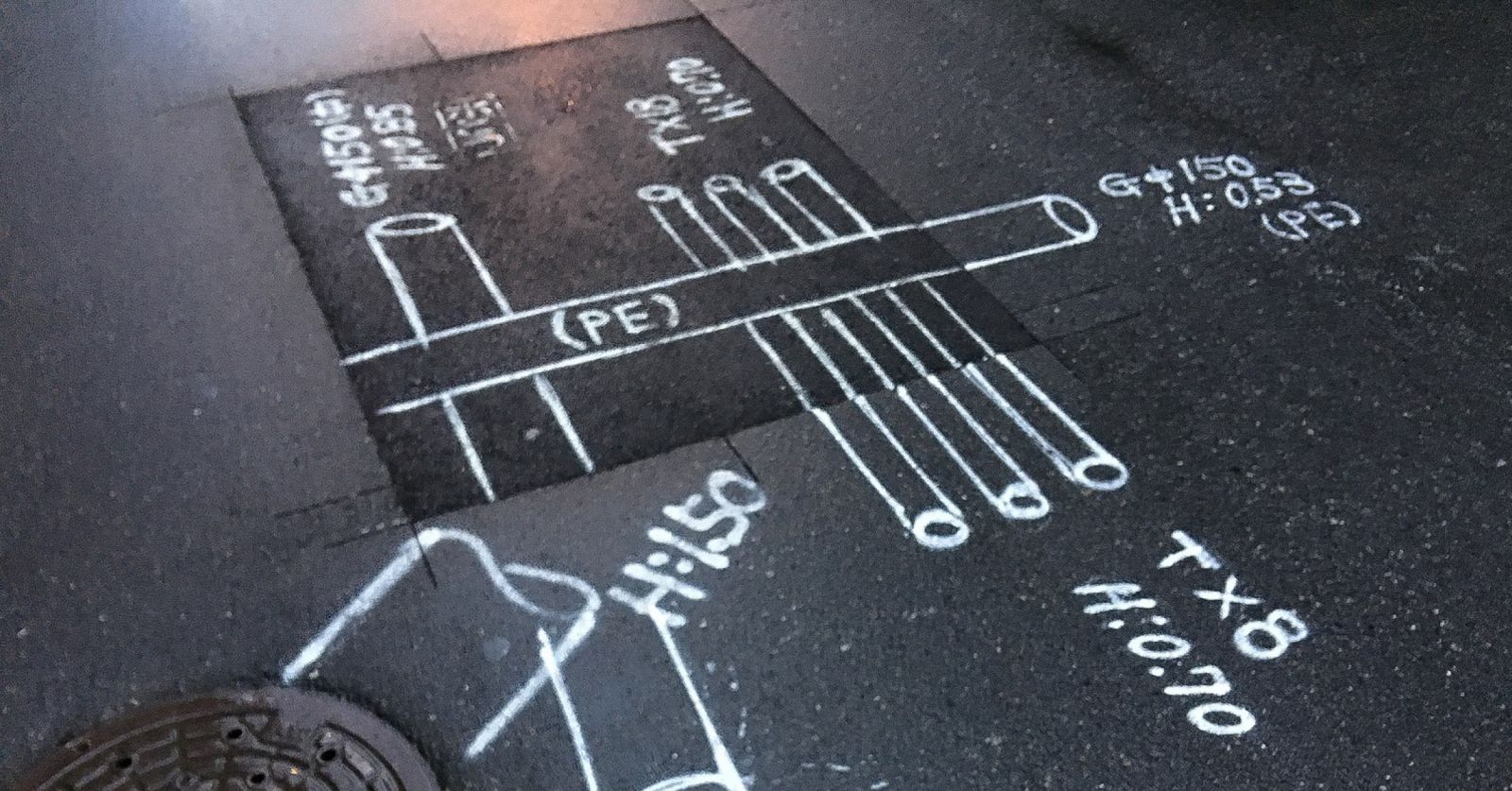A Comprehensive Guide to Road Traffic Control Equipment
Read more...
Author: Harry Watt Date Posted:19 January 2021
Chances are you’ve seen a bunch of different markings on the ground with different colours and symbols but haven't taken the time to stop and think about what they actually mean.
Site workers, managers and engineers needed a way to tell where utilities were located beneath the surface of the ground and what they were. Thanks to the Australian colour coding system for utilities and pipe and cable locating, they got one. Universal colour coding for site surveying, spot and line marking have become the Australian standard, providing a fool-proof method to avoid damaging unseen utilities.
What's the difference? Line marking is your permanent markings used for car parks and roads. Spot paint however is applied mostly by hand or with an applicator gun specifically designed for upside down use. The formulation of spot paint works a treat on a variety of surfaces like dirt, bitumen and even grass, especially if high quality.

Before starting any job involving excavating in an unknown area, check out this best practice guide from Dial Before You Dig. When it comes to locating underground infrastructure, make sure to use the correct colour and note the size of what's below, along with any important measurements that may be relevant to the excavation.
Take a look at the Australian standard paint colours for utilities:

Orange is the colour for electrical equipment. Orange can indicate the subterranean presence of power lines, cables, conduits, transformers, or even lightning cables.
Yellow is the identifier for natural gas, petroleum, or steam. It’s the colour for urgency and caution. Anyone who’s tapped into a gas line and lived to tell the tale knows the value of accurate markings for gas lines. Oil and steam can be almost as problematic.
White indicates communications. This could include cable TV, phone systems, alarm wiring, fibre optics, or conduits intended to carry signals rather than power. With our modern reliance on telecommunications, it’s wise to be careful when digging around orange markings.
Green, Purple and Blue all indicate water of different types and varieties. it is commonplace for recycled water, potable water, and stormwater all to have separate underground infrastructure. Identifying and avoiding these during excavation is crucial.
Multi- coloured markings are generally found in more suburban areas, where there is a high density of underground utilities and therefore a greater importance for clarity among excavators. No one wants to damage the wrong pipe or cable, like this bloke did...
While colours alone specify what exactly lies below the surface, they are not the only part of the equation. Symbols are an essential part in helping identify widths, depths, locations and basically anything to help 'paint' a picture for anyone wanting to excavate.

Symbols let the locator contractor, excavation operator, surveyor and everyone in-between have a clear picture of what's below the ground. Basically, there are four classes. QL-(A) sighted, QL-(B) traced, QL-(C) aligned from surface features, QL-(D) any other method.
Thanks to organisations like Dial before you Dig and the National Utility Locating Contractors Association (NULCA), we have a standard that is truly Australian, without any replication of standards used by the United States.
So next time you spot these weird little markings, see if you can figure out what they mean. Definitely do not use your new-found knowledge of spot paint markings to pick up the local bartender - but at least it’s something to think about…

Read more...

Read more...

Read more...

Read more...

Read more...

Subscribe to our newsletter to get exclusive deals and updates!
 Afterpay
Afterpay Bank Deposit
Bank Deposit PayPal Express
PayPal Express Web Payments
Web Payments Web Payments
Web Payments MasterCard
MasterCard Visa
VisaWelcome to our website. If you continue to browse and use this website, you are agreeing to comply with and be bound by the following terms and conditions of use, which together with our privacy policy govern EagleXP T/A Workshop360’s relationship with you in relation to this website. If you disagree with any part of these terms and conditions, please do not use our website.
The term ‘EagleXP T/A Workshop360’ or ‘us’ or ‘we’ refers to the owner of the website whose registered office is Unit 1, 18 Gravel Pit Road, Darra, QLD, 4076. Our ABN is 14 622 985 068. The term ‘you’ refers to the user or viewer of our website.
The use of this website is subject to the following terms of use:
This Privacy Policy describes how your personal information is collected, used, and shared when you visit or make a purchase from www.workshop360.com.au (the “Site”).
When you visit the Site, we automatically collect certain information about your device, including information about your web browser, IP address, time zone, and some of the cookies that are installed on your device. Additionally, as you browse the Site, we collect information about the individual web pages or products that you view, what websites or search terms referred you to the Site, and information about how you interact with the Site. We refer to this automatically collected information as “Device Information”.
We collect Device Information using the following technologies:
Additionally, when you make a purchase or attempt to make a purchase through the Site, we collect certain information from you, including your name, billing address, shipping address, payment information (including credit card numbers & payment account numbers Paypal, Afterpay, ZipPay), email address, and phone number. We refer to this information as “Order Information”.
When we talk about “Personal Information” in this Privacy Policy, we are talking both about Device Information and Order Information.
We use the Order Information that we collect generally to fulfil any orders placed through the Site (including processing your payment information, arranging for shipping, and providing you with invoices and/or order confirmations). Additionally, we use this order information to:
We use the Device Information that we collect to help us screen for potential risk and fraud (in particular, your IP address), and more generally to improve and optimize our Site (for example, by generating analytics about how our customers browse and interact with the Site, and to assess the success of our marketing and advertising campaigns).
We share your Personal Information with third parties to help us use your Personal Information, as described above.
We also use Google Analytics to help us understand how our customers use the Site-you can read more about how Google uses your Personal Information here: https://www.google.com/intl/en/policies/privacy/. You can also opt-out of Google Analytics here: https://tools.google.com/dlpage/gaoptout.
Lastly, we may also share your Personal Information to comply with applicable laws and regulations, to respond to a subpoena, search warrant or other lawful request for information we receive, or to otherwise protect our rights.
As described above, we use your Personal Information to provide you with targeted advertisements or marketing communications we believe may be of interest to you. For more information about how targeted advertising works, you can visit the Network Advertising Initiative’s (“NAI”) educational page at http://www.networkadvertising.org/understanding-online-advertising/how-does-it-work.
You can opt out of targeted advertising by:
Facebook - https://www.facebook.com/settings/?tab=ads
Google - https://www.google.com/settings/ads/anonymous
Bing - https://advertise.bingads.microsoft.com/en-us/resources/policies/personalized-ads
Additionally, you can opt-out of some of these services by visiting the Digital Advertising Alliance’s opt-out portal at: http://optout.aboutads.info/.
You can also do a blanket opt-out of targeted advertising at http://www.youronlinechoices.com.au/ for companies who have signed up to “Your Online Choices”.
This website uses the Google AdWords remarketing service to advertise on third party websites (including Google) to previous visitors to our site. It could mean that we advertise to previous visitors who have completed a task on our site, for example using the contact form to make an enquiry or making a purchase.
This could be in the form of an advertisement on the Google search results page, or a site in the Google Display Network. Third-party vendors, including Google, use cookies to serve ads based on someone’s past visits to this website. Of course, any data collected will be used in accordance with our own privacy policy and Google’s privacy policy.
You can set preferences for how Google advertises to you using the Google Ad Preferences page.
Please note that we do not alter our Site’s data collection and use practices when we see a Do Not Track signal from your browser.
Under Australia Consumer Law you are entitled to rights regarding the collection and usage of your information. For more information on your rights visit the ACCC website: www.accc.gov.au
When you place an order through the Site, we will maintain your Order Information for our records unless and until you ask us to delete this information.
We may update this privacy policy from time to time in order to reflect, for example, changes to our practices or for other operational, legal or regulatory reasons.
For more information about our privacy practices, if you have questions, or if you would like to make a complaint, please contact us by e-mail at admin@workshop360.com.au or by mail using the details provided below:
Unit 1/18 Gravel Pit Road, DARRA, QLD, 4076, AUSTRALIA


Add your favourites to cart

Select Afterpay at checkout

Log into or create your Afterpay account, with instant approval decision

Your purchase will be split into 4 payments, payable every 2 weeks
All you need to apply is to have a debit or credit card, to be over 18 years of age, and to be a resident of country offering Afterpay
Late fees and additional eligibility criteria apply. The first payment may be due at the time of purchase
For complete terms visit afterpay.com/terms
